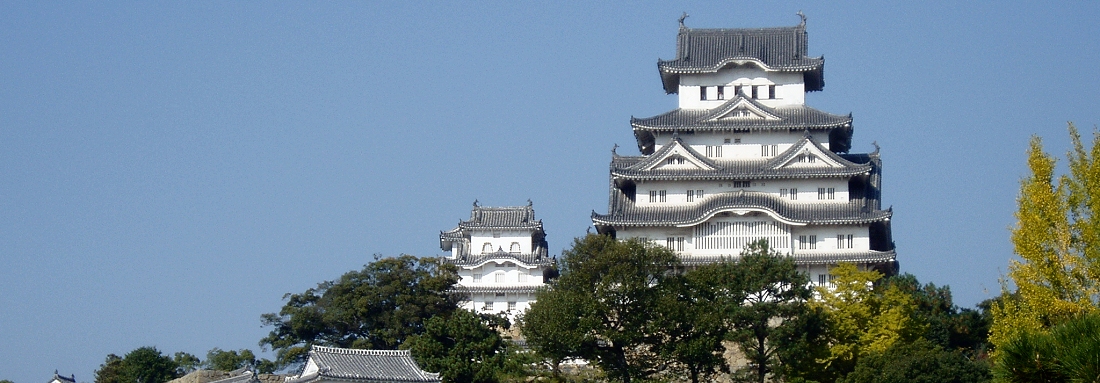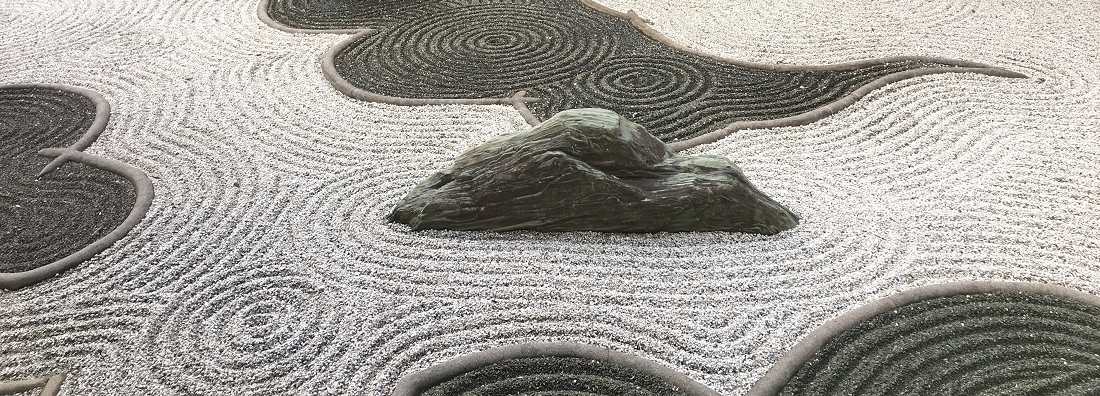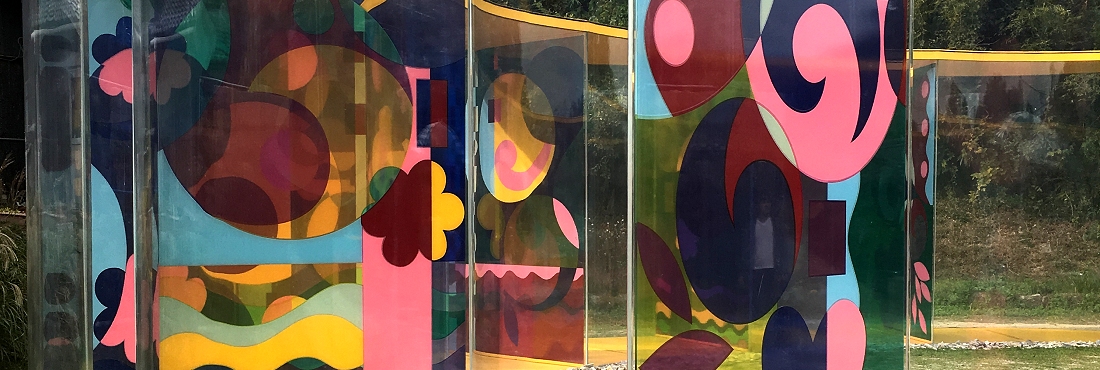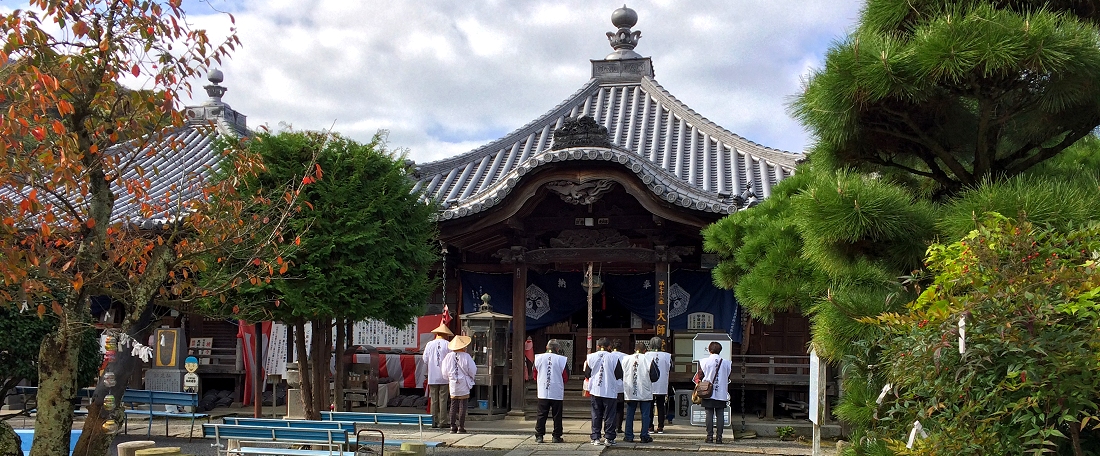
Himeji Castle (Himeji-jō) is perhaps the finest extant example of Japanese castle architecture.
November 12-21, 2024
Plan your arrival in Kyoto, Japan for Monday, November 11
Plan your departure from Takamatsu, Japan for Friday, November 22
Traveling in Japan in 2024: What to Expect
Join Amy Osaki for a newly designed trip exploring the heritage of Japan. Step into thousands of years of Japanese history. Visit Nijo Castle (the former residence of the Tokugawa shogun) and Himeji and Matsue Castles, two of only twelve remaining samurai castles from the 17th century in Japan. Delve into masterworks of Japanese gardens in Kyoto where you’ll visit temple gardens as well as the home of a famous garden designer. Plunge into the riches of 21st century art during a two-night stay at the Tadao Ando-designed Benesse House on Naoshima, an island in the Seto Inland Sea. While there, travel to the neighboring art islands of Teshima and Inujima. Visit remote centers of art and gardens at the Adachi Museum and the Ohara Museum. In the interior of Shikoku you’ll visit two temples (Temples 71 and 75) that are part of the Shikoku 88 Temple Pilgrimage, an eleven hundred year old, 800 mile long route that encircles the island. This pilgrimage is closely associated with the life of Kōbō Daishi, a eighth century Buddhist monk born near Temple 75 in the year 774. (During your time in Kyoto you’ll visit Toji, an eighth century temple that is also significant to the life of Kōbō Daishi). This trip is timed to catch fall in Japan, and if the vagaries of weather permit, we’ll be able to enjoy the spectacle of crimson Japanese maple leaves. Whether this is your first trip to Japan (or one of many) you’re invited to join Amy for an experience that combines the well-known attractions of Japan with lesser-known adventures off-the-beaten-path.

The 2014 Heisei Chishinkan Wing of the Kyoto National Museum designed by Yoshio Taniguchi.
Day 1 – Kyoto: Kyoto National Museum, Kawai Kanjiro
Overnight Kyoto
Lunch & dinner included
In 1853 Japan signed trade agreements with western governments including the United States and emerged from over 200 years of isolation. The shoguns transferred power back to the Emperor and in 1869 the capital was moved from Kyoto to Tokyo. This began the Meiji Restoration, a period of rapid modernization in Japan. The Kyoto National Museum was established in 1897 as one of three national museums founded to preserve traditional culture, antiquities, temples and shrines. We will tour the museum’s impressive collection of ceramics, painting, calligraphy, textiles, sculpture and lacquer. In addition, visit the museum’s new wing designed by architect Yoshi Taniguchi (who also designed the MOMA in New York). After lunch, proceed to the private home of Kawai Kanjiro, a ceramic artist who led a movement known as “mingei” whose aim was to perpetuate traditional Japanese folk arts at risk of disappearing due to the rapid modernization. Preserved by his family, the home exhibits over four decades of his art as well as the kiln (one of only 4 surviving in Kyoto) used by Kanjiro and other artists to fire their work. Enjoy a welcome dinner tonight.

Detail, Nijo Castle Gate, Kyoto.
Day 2 – Kyoto: Toji Temple, Nijo Castle
Overnight Kyoto
Breakfast & lunch included
Begin the day at the temple of To-ji founded in the eighth century as one of the “guardian” temples of the Imperial capital. The temple features a five-story pagoda (Japan’s tallest) dating from the mid-seventeenth century. Here we’ll begin to learn about Kōbō Daishi, the ninth century monk who was granted the stewardship of To-ji in 823. Today, To-ji remains one of the three most important sites associated with the life of Kōbō Daishi. After lunch, step into the past at Nijo Castle. Spend a leisurely afternoon exploring the world of the shoguns and samurai. Visit the palaces and the gardens of the Nijo Castle World Heritage Site built in 1601 for the Tokugawa shogun. Dinner on your own this evening.

Himeji Castle.
Day 3 – Himeji Castle
Overnight Kyoto
Breakfast & lunch included
After breakfast, travel via high speed train (shinkansen) to Himeji town. Spend the day exploring Himeji castle built in 1609 and the best preserved of the feudal castles in Japan. The castle was recently reopened after an extensive renovation. Traverse the moat, pass through the gate, follow stone paths, and if you wish, climb the many flights of stairs to the summit of the inner keep of the castle where you can gaze out over the town. In the afternoon, return by train to Kyoto. Enjoy dinner on your own.

Dry landscape garden (karesansui) at Tofukuji.
Day 4 – Kyoto: Tofukuji Temple and Mirei Shigemori Garden Museum
Overnight in Kyoto
Breakfast & lunch included
Tofukuji, a temple built in 1236, is known for its spectacular display of fall foliage. Less well known are the four gardens at the head priest’s residence designed by Mirei Shigemori. In 50 years, Shigemori designed more than 180 gardens in Japan and worked with Isamu Noguchi on the UNESCO garden in Paris. In the morning, we will visit Shigemori’s home and private garden, and in the afternoon the temple and gardens at Tofukuji. Shigemori described the melding of the classical and contemporary in garden design as “eternal modern” and his descendents have preserved his home and garden as a museum.

Art installation on Inujima.
Day 5 – Art Islands: Teshima and Naoshima
Overnight on Naoshima
Breakfast, lunch & dinner included
Depart Kyoto and travel by train to Okayama, then by private bus to Uno port, and board a ferry to Teshima island. Teshima is part of the visionary contemporary art program of the publishing firm, Benesse House. In response to the growing migration away from the isolated islands of Japan, Benesse House created a stunning art museum on Naoshima in 1992. In 2010, a new program on Teshima Island opened as the Teshima Art Museum designed by architect Ryue Nishizawa and artist Rei Naito. The result is the “successful integration of art, architecture, and nature.” After the museum visit, in the late afternoon, journey by boat from Teshima to Naoshima where you’ll settle in for a two night stay at the Benesse House Park Hotel designed by Tadao Ando. After dinner, you may visit the Benesse House Museum which is open to hotel guests until 11pm.

Yayoi Kusama’s “Pumpkin” on Naoshima.
Day 6 – Naoshima: Three Museums
Overnight on Naoshima
Breakfast, lunch & dinner included
After breakfast, immerse yourself in the contemporary art on Naoshima. Visit three museums: Benesse House Museum, Lee Ufan Museum, and Chichu Art Museum. All were designed by architect Tadao Ando. After lunch, explore six art houses in the seaside village of Honmura. Experience site-specific installations that have been created by artists in houses and even in an old shrine, and tour the Tadao Ando Museum. Return to your Tadao Ando designed hotel room at Benesse House Park. Relax and enjoy dinner at Benesse House. After dinner, you may once again visit the Benesse House Museum which is open to hotel guests until 11pm. In addition, enjoy over forty artworks in the hotel and on the grounds of the hotel and the museum.

Sculpture at the Ohara Museum.
Day 7 – Art Island: Inujima and the Seirensho Museum and the Art Houses
Overnight in Matsue
Breakfast, lunch & dinner included
This morning travel by ferry from Naoshima to Inujima, an island in the Seto Inland Sea. Opened to the public in 2008, the Seirensho Museum on Inujima was created by architect Hiroshi Sambuichi and artist Yukinori Yanagi. There are also five art houses in Inujima village, a project led by architect Kazuyo Sejima and art director Yuko Hasegawa. Revel in the tranquility of the village and contemplate the industrial legacy and subsequent rebirth of this remote island. After the visit to Inujima, continue north to Matsue, a city near the coast of the Sea of Japan. Settle in for a two-night stay and enjoy dinner together.

Garden at the Adachi Museum.
Day 8 – Adachi Museum, Lafcadio Hearn Museum, Matsue Castle
Overnight in Matsue
Breakfast and lunch included
Travel by private bus to the Adachi Museum. Created by Zenko Adachi, the museum melds its art collection with its garden. Adachi designed the gardens to be viewed simultaneously with the paintings and strived for the viewer to be “moved by beauty.” Adachi said, “The garden is, so to speak, a picture scroll.” You can take a virtual step into the gardens thanks to the Google Art Project. The Adachi Museum also exhibits a collection of ceramics by Kawai Kanjiro. Return to Matsue and continue the journey into 19th century Japan with a visit to the home and museum of Lafcadio Hearn. Hearn arrived in Japan in 1890 on assignment for Harper’s Monthly magazine. In Matsue, he married Setsu Koizumi in 1896 and became a naturalized Japanese citizen. He wrote 30 books celebrating the beauty and mystery of old Japan. Afterwards, tour Matsue Castle before returning to our hotel. Enjoy dinner on your own this evening.

View at Ritsurin Gardens.
Day 9 – Nagi MOCA and Ohara Museum
Overnight in Takamatsu
Breakfast & lunch included
Today board a private bus for the journey south. Stop at the innovative Nagi Museum of Contemporary Art described by the New York Times as “more startlingly original than any built by a major city in recent years.” Conceived and designed by Arata Isozaki (who also designed the Museum of Contemporary Art in Los Angeles), this innovative museum is a delight and a splendid example of site-specific contemporary art. After the museum visit, continue by private bus to the Ohara Museum in Kurashiki. Opened in 1930, the Ohara Museum was the first museum in Japan to exhibit western art. Works by Monet, Renoir, Picasso, Matisse, and Calder fill the galleries. Some, including Waterlilies by Claude Monet, were purchased directly from the artist in the 1920s. Ohara’s son expanded the collection to include Japanese craft including ceramics by Kawai Kanjiro and Bernard Leach who was a British potter and leader with Kanjiro in the “mingei” movement to preserve traditional Japanese folk art. Following the visit to the Ohara Museum, travel across the Inland Sea via the Seto Ohashi (bridge) to the island of Shikoku and the city of Takamatsu. Settle in for a two-night stay. Dinner on your own this evening.

Pilgrims on the Shikoku 88 Temple Pilgrimage.
Day 10 – Ritsurin Gardens, 88 Temple Pilgrimage
Overnight in Takamatsu
Breakfast, lunch & dinner included
In the morning, wander the spacious grounds of Takamatsu’s Risturin Garden (Ritsurin Koen) containing several ponds and hills along with elegantly sculpted trees and manicured plantings. Ritsurin Koen dates from the beginning of the early seventeenth century, and is frequently recognized as one of the finest landscape gardens in Japan. After the visit to the gardens, you’ll have an opportunity to experience a portion of the 88 Temple Pilgrimage, a route closely associated with the life of Kōbō Daishi who was born in northern Shikoku in the late eighth century not too far from Takamatsu. Travel by bus from Takamatsu to visit two temples–Iyadaniji (Temple 71) and Zentsuji (Temple 75) and learn about the pilgrims (known as henro in Japanese) who travel from all over Japan and the world to undertake the pilgrimage. Zentsuji was the home temple of Kobo Daishi who was born to a minor aristocratic family in the year 774. Consider purchasing a temple stamp book (called a nokyocho). At each temple office, you can have someone stamp your book with the vermilion stamps bearing the temple’s name. Then, using a calligraphy brush, symbols representing the main deity of the temple are handwritten in your book. You can acquire a blank book that you can use for any temple in Japan or a special book made specifically for the Shikoku 88 Temple Pilgrimage. Perhaps you will return someday to complete the entire route! Return to Takamastu for a farewell dinner and overnight.
Other Details about this Trip
Trip Dates:November 12-21, 2024
Trip Leader: Amy Boyce Osaki
Price: $8,495
Single Room for entire trip: $1,330
Meeting Point: The trip begins at the hotel in Kyoto on the morning of November 12, 2024.
Departure Point: The trip concludes after dinner at the hotel in Takamatsu on November 21, 2024. However, your overnight lodging in Takamatsu this evening and breakfast the following morning are included in the trip price.
Lodging: Ten nights of lodging in hotels/inns. Private western-style hotel rooms with private bathing facilities. Please note that your lodging in Kyoto on the night before the trip begins is not included in the trip price, but we will be happy to book accommodations for you on that evening.
Meals: Ten breakfasts, ten lunches (packed lunch or restaurant depending on the day), and five dinners are included. Meals are normally Japanese-style.
Also included in the trip price: Access to museums and attractions, admission to all sites, all ground transportation, expert insights into the art and culture of Japan provided by your trip leader and local experts.
Not included in the trip price: Airfare, excess baggage charges, personal insurance, meals not mentioned in the itinerary, and all items of a personal nature such as drinks, laundry, telephone, and internet access. Lodging in Kyoto on the evening prior to the start of the trip is not included in the tour price.
Resources for Further Learning
- Virtual museum visits: Kyoto National Museum, Himeji Castle, Adachi Museum, Ohara Museum of Art, Benesse House Museum.
- To learn more about Kōbō Daishi and the Shikoku 88 Temple Pilgrimage visit David Turkington’s excellent website, Shikoku Henro Trail.
We're looking forward to hearing from you! You may contact us by telephone at 503-788-9017, by e-mail (info@arttoursbyamy.com) or by completing and submitting the form below. Please enter any questions or comments in the "Message" box. PLEASE BE SURE TO MENTION THE TRIP IN WHICH YOU'RE INTERESTED. You must enter a valid email address in order to submit this form successfully. When you're finished entering information, enter the CAPTCHA code where indicated and click the "Submit" button at the bottom of this page. Art Tours by Amy does not release any of the information you provide us to any third party without your express permission.

Origami cranes in Kyoto.
Photos on this page are by Amy Boyce Osaki (© All Rights Reserved). The photo of Shusshaka-ji is by John Osaki (© All Rights Reserved).


Recent Comments